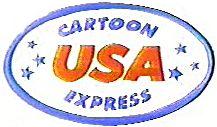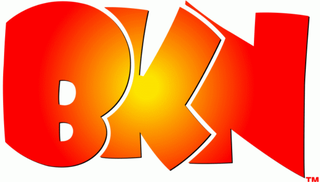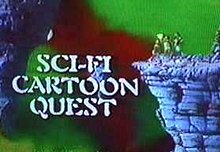Animation in the United States in the television era was a period in the history of American animation that slowly set in with the decline of theatrical animated shorts and the popularization of television animation during the late 1950s to 1960s, peaked in the 1970s, and ended in the mid-late 1980s. This era is characterized by low budgets, limited animation, an emphasis on television over the theater, and the general perception of cartoons being primarily for children. Due to the perceived cheap production values, poor animation, and mixed critical and commercial reception, this era is sometimes referred to as the Dark Ageof American animation by critics.
"Saturday-morning cartoon" is a colloquial term for the original animated series and live-action programming that was typically scheduled on Saturday and Sunday mornings in the United States on the "Big Three" television networks. The genre's popularity had a broad peak from the mid-1960s through the mid-2000s; over time it declined, in the face of changing cultural norms, increased competition from formats available at all times, and heavier regulations. In the last two decades of the genre's existence, Saturday-morning and Sunday-morning cartoons were primarily created and aired to meet regulations on children's television programming in the United States, or E/I. Minor television networks, in addition to the non-commercial PBS in some markets, continue to air animated programming on Saturday and Sunday while partially meeting those mandates.
Toonami is an American late-night television programming block that broadcasts Japanese anime and American action animation. It was created by Sean Akins and Jason DeMarco and produced by Williams Street, a division of Warner Bros. Television Studios, and owned by The Cartoon Network, Inc. subsidiary of Warner Bros. Discovery. The name is a portmanteau of the words "cartoon" and "tsunami". It currently broadcasts every Saturday night from 12 a.m. to 3 a.m. ET/PT.

Boomerang is an American cable television network owned by Warner Bros. Discovery U.S. Networks, a subsidiary of Warner Bros. Discovery.

Return to the Planet of the Apes is a 1975 American animated television series based on the 1968 film Planet of the Apes and its sequels, which were, in turn, based on the 1963 novel of the same name by Pierre Boulle. Unlike the film, its sequels, and the 1974 live-action television series, which involved a primitive ape civilization, Return to the Planet of the Apes depicted a technologically advanced society, complete with automobiles, film, and television; as such it more closely resembled both Boulle's original novel and early concepts for the first Apes film which were changed due to budgetary limitations in the late 1960s.

The USA Cartoon Express was a programming block consisting of animated children's series which aired on the USA Network from September 20, 1982 to September 15, 1996. Cartoon Express was the first structured animation block on cable television, predating Nickelodeon's Nicktoons and Cartoon Network by a decade.

The Funtastic World of Hanna-Barbera is an American animated syndicated programming block produced by Hanna-Barbera Productions that ran on a weekly schedule and was performed in live action. The program ran from 1985 to 1994.
A weekday cartoon is the colloquial term for the animated series programming that was typically scheduled on weekday mornings and afternoons in the United States on many major television networks and in broadcast syndication since the 1960s.

The New Adventures of Flash Gordon, also known as The Adventures of Flash Gordon, is a 1979–1982 animated television series. The series is actually called Flash Gordon but the expanded title is used in official records to distinguish it from previous versions. Filmation produced the series in 1979, partly as a reaction to the mammoth success of Star Wars in 1977. The series was an homage to the original Flash Gordon comic strip and featured many of the original characters, including Flash's girlfriend Dale Arden, and the scientist Hans Zarkov. The series is still regarded as one of the most faithful adaptations, and one of Filmation's finest overall efforts.

The Sci-Fi Channel's Animation Station was a block of animation or puppetry-related television shows on the Sci Fi Channel. Some of the shows shown were Ronin Warriors, Star Wars: Droids, Star Wars: Ewoks, Transformers, Bionic Six, and The New Adventures of Gigantor.

Bohbot Kids Network was a children's programming block operated by Bohbot Entertainment that aired on syndicated television stations from 1992 to 2000.

Cartoon Network Australia & New Zealand is an Australian pay television channel launched on October 3, 1995 and owned by Warner Bros. Discovery Asia-Pacific. It primarily shows animated programming.

Télétoon is a Canadian French language specialty channel owned by Teletoon Canada, Inc., a subsidiary of Corus Entertainment. Its name is a portmanteau of "télévision" and "cartoon". Until March 2023, the channel had an English-language counterpart named Teletoon, which was renamed Cartoon Network on March 27, 2023, although Télétoon remains its French-language counterpart. Télétoon broadcasts animated series with kids and teens.

Cartoon Network is an Indian cable and satellite television channel operated by Warner Bros. Discovery under its international division. The channel is the Indian equivalent to the original American network and was launched on 1 May 1995 as the first television network in India dedicated to children. The channel primarily airs animated programming in Hindi, Tamil, Telugu, Kannada, and Malayalam.

Animation Domination is an American animated programming block which has aired in two iterations on the Fox broadcast network, featuring a lineup solely made up of prime-time animation and adult animation carried as a majority of, or the whole of, the network's Sunday evening schedule. It originally ran from May 1, 2005, until September 21, 2014, before returning on September 29, 2019.

Animation Domination High-Def was a late-night programming block broadcast by Fox. Originally premiering on July 21, 2013 as a spin-off of Animation Domination, the block originally focused on new, original adult animation series—similarly in style to Adult Swim. The ninety-minute block and its content were primarily produced by Friends Night, a television animation studio headed by Adult Swim alumni Nick Weidenfeld, Hend Baghdady, and creative director Ben Jones —including its programs, along with interstitials and other content featured during its programming.

Disney XD is an American pay television channel owned by the Disney Branded Television and Disney Entertainment units of The Walt Disney Company. The channel is aimed primarily at older children ages six to eleven years old.
Univision y Los Niños is a former American children's programming block that airs on the Spanish-language television network Univision which premiered on June 26, 1989, to September 15, 1990. The two-hour block—which airs Monday to Friday and Saturday morning cartoon from 7:00 to 9:00 a.m. ET/PT—features the network was in partnership with DIC Entertainment including animated series aimed at children between the ages of 2 and 14. It was the network's attempt to have a Saturday morning block.












